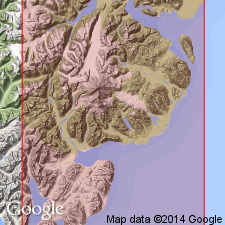
- Usage in publication:
-
- Marsh Creek Breccia Member*
- Modifications:
-
- Named
- Dominant lithology:
-
- Breccia
- Argillite
- AAPG geologic province:
-
- Alaska Southwestern region
Summary:
Pg. 13-14, pls. Marsh Creek Breccia Member, basal member of Talkeetna Formation. A volcanic breccia and argillite interbedded with lava flows. Dominantly dark-green to green volcanic breccia. Much of breccia has tuff matrix and is actually a tuff breccia. Bedding not readily discernible in many of the massive units that range from 40 to as much as 1,100 feet thick. Thickest (3,350 feet) at type section. Section between Iniskin Bay and Marsh Creek (Clearwater Creek) is 3,100 feet thick but is not as well exposed. Is in fault contact with overlying Portage Creek Agglomerate Member (new) of Talkeetna Formation. Overlies unnamed metamorphic rocks. Intruded by quartz monzonite. Age is stated to be Early Jurassic (map legend). May correlate with upper part of type Talkeetna and if so, is of Toarcian age.
Type section: along south shore of Tuxedni Bay, starting 6 mi northwest of Fossil Point and continuing 2.25 mi to contact with quartz diorite pluton, Cook Inlet region, southwestern AK. Best exposed in belt 1 to 2 mi wide from head of Iniskin Bay northeastward to south slope of Iliamna Volcano. Named from Marsh Creek, Iniskin-Tuxedni region, southwestern AK.
Source: US geologic names lexicon (USGS Bull. 1350, p. 470); supplemental information from GNU records (USGS DDS-6; Menlo GNULEX).
For more information, please contact Nancy Stamm, Geologic Names Committee Secretary.
Asterisk (*) indicates published by U.S. Geological Survey authors.
"No current usage" (†) implies that a name has been abandoned or has fallen into disuse. Former usage and, if known, replacement name given in parentheses ( ).
Slash (/) indicates name conflicts with nomenclatural guidelines (CSN, 1933; ACSN, 1961, 1970; NACSN, 1983, 2005, 2021). May be explained within brackets ([ ]).

